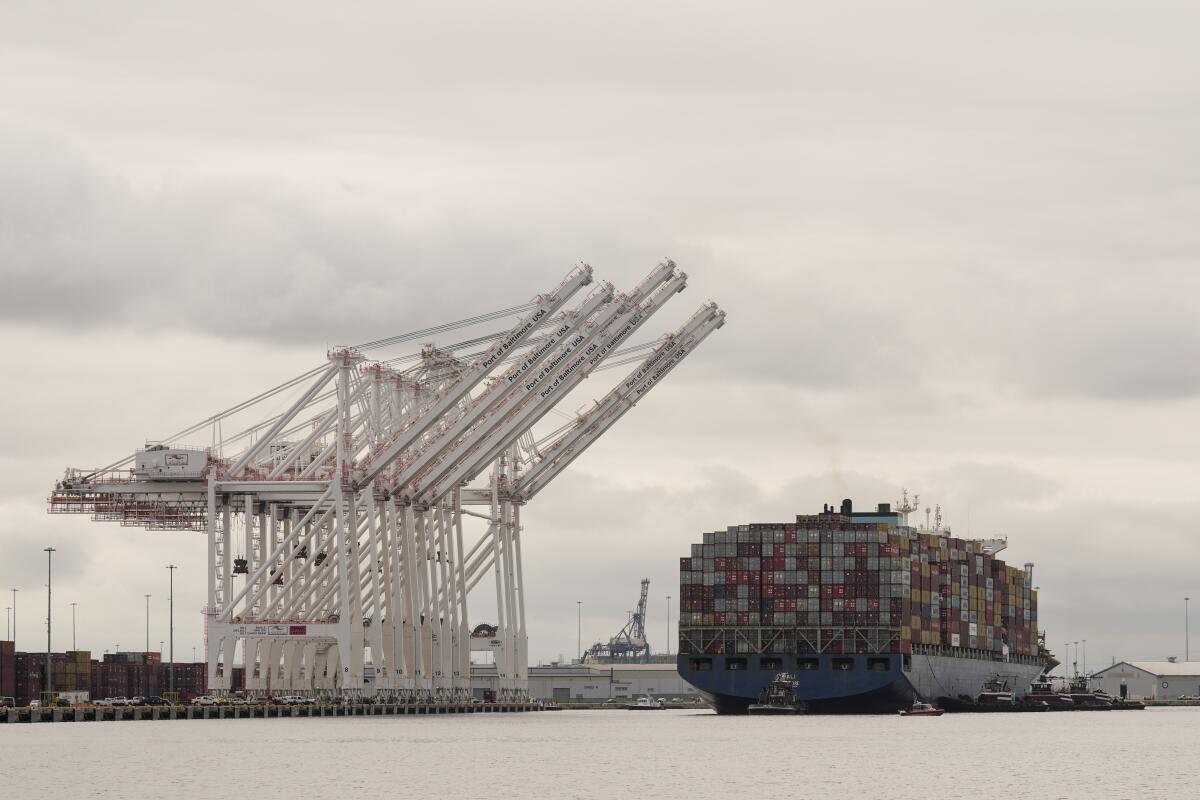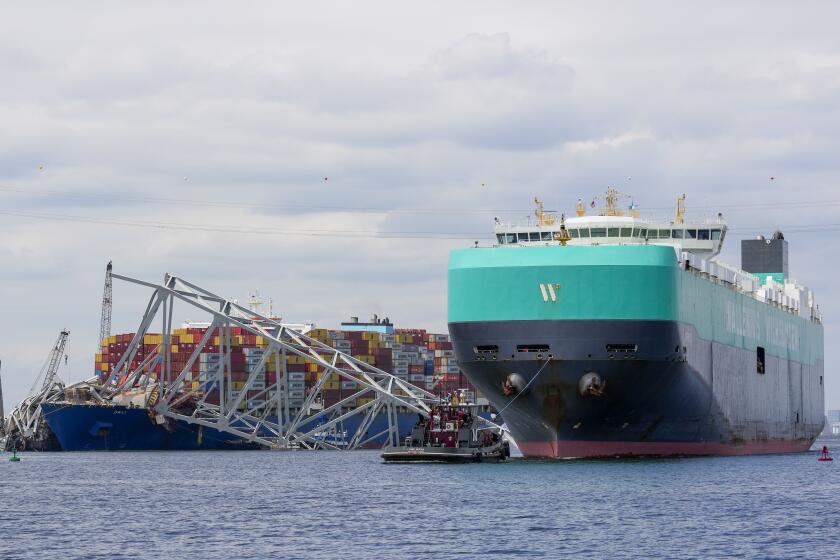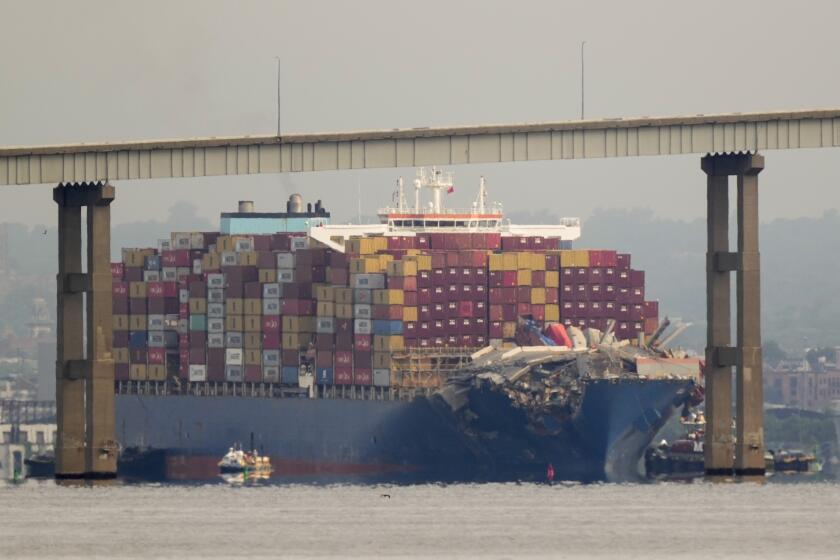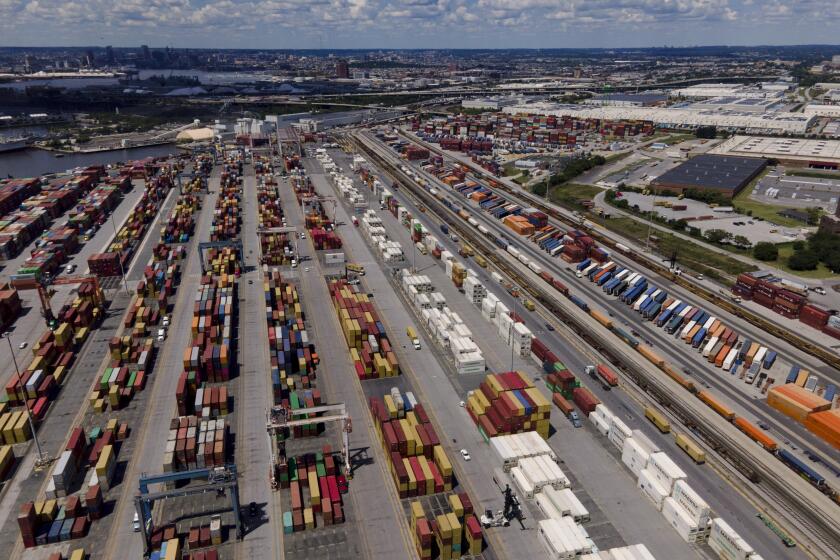Baltimore’s busy port fully reopens after bridge collapse

- Share via
BALTIMORE — Authorities anticipate commercial shipping traffic through the Port of Baltimore will soon return to normal levels after the channel fully reopened this week for the first time since the Francis Scott Key Bridge collapse.
“They are back open for business, ready to bring in the largest container ships that call there,” U.S. Coast Guard Rear Adm. Shannon Gilreath said during a virtual press briefing Tuesday afternoon.
Some shipping companies rerouted their cargo to other ports following the deadly bridge collapse in March. The disaster halted most maritime traffic through Baltimore’s busy port as crews worked around the clock to clear an estimated 50,000 tons of fallen steel and concrete from the Patapsco River, a roughly $100-million effort that involved federal, state and local agencies, officials said. Maryland used about $60 million in federal emergency funds to open three other smaller channels outside of the main one.
The first cargo ship passed through a newly opened channel in Baltimore after being stuck in the harbor since the Francis Scott Key Bridge collapsed.
Companies that steered clear of Baltimore during the cleanup efforts will likely come back now that the channel has been returned to its original depth and width, officials said. The city’s port processes more cars and farm equipment than any other in the country.
All that rerouted commercial traffic “belongs in Baltimore today,” U.S. Transportation Secretary Pete Buttigieg said. “We have every indication that that is what is taking place, but we will be reinforcing that expectation as we speak with players up and down the supply chains.”
Crews were able to reopen portions of the deep-draft channel in phases, restoring some commercial traffic in recent weeks. Some cruise ships and large container ships have already passed through, officials said.
But thousands of longshoremen, truckers and small business owners have seen their jobs affected by the collapse and its economic ripple effects, which extend well beyond the Baltimore region. State officials helped establish several relief programs to keep people employed and businesses afloat in the immediate aftermath.
The container ship that caused the deadly collapse of Baltimore’s Francis Scott Key Bridge was slowly escorted back to port.
Officials estimated the salvage operations will cost $75 million, while the Coast Guard response has cost $24 million to date to open the main channel.
Rebuilding the bridge could cost nearly $2 billion, officials have said. They hope it’s completed by 2028.
President Biden has pledged that the federal government will cover the full cost of rebuilding the bridge, though officials said the funding is still awaiting approval from Congress.
In a statement Tuesday, Biden praised the work of everyone involved in the recovery effort to date.
“Baltimore can count on us to stick with them every step of the way, and we will continue to have your back until the bridge is rebuilt,” he said.
The collapse of the Francis Scott Key Bridge and the closure of the Port of Baltimore this week could have far-reaching implications all the way across the country for the ports of Los Angeles and Long Beach, according to several experts.
The cargo ship Dali crashed into a critical support column of the Francis Scott Key Bridge in the early hours of March 26, collapsing the span and sending six members of a roadwork crew plunging to their deaths. The ship had lost power shortly after leaving Baltimore for Sri Lanka. A National Transportation Safety Board investigation found it experienced power outages before starting its voyage, but the exact causes of the electrical issues have yet to be determined. The FBI is also conducting a criminal investigation into the circumstances leading up to the collapse.
The Dali remained stuck amid the wreckage for almost two months, with a massive steel truss draped across its damaged bow. On May 20, the ship was refloated and guided back to port. That allowed officials to open a channel that was 50 feet deep and 400 feet wide, big enough for most of the largest commercial vessels.
The full federal shipping channel is 700 feet wide. Officials said two-way traffic can resume now that it has reopened. They said additional safety requirements have also been lifted because of the increased width.
Skene and Witte write for the Associated Press.
More to Read
Sign up for Essential California
The most important California stories and recommendations in your inbox every morning.
You may occasionally receive promotional content from the Los Angeles Times.













